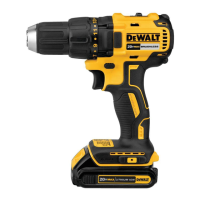ENGLISH
33
Screwdriving (Fig. A, J)
1. Select the desired speed/torque range using the gear
shifter
4
to match the speed and torque to the planned
operation.
2. Turn the torque adjustment collar
3
to the desired
position.
NOTE: Use the lowest torque setting required to
seat the fastener at the desired depth. The lower the
number, the lower the torque output.
3. Insert the desired fastener accessory into the chuck as
you would any drill bit.
4. Make some practice runs in scrap or on unseen areas of
the workpiece to determine the proper position of the
torque adjustment collar.
5. Always start with lower torque settings, then advance
to higher torque settings to avoid damage to the
workpiece or fastener.
Hammerdrilling (Fig. A, K)
1. Select the desired speed/torque range using the gear
shifter
4
to match the speed and torque to the planned
operation. Turn the collar
3
to the hammerdrillsymbol.
IMPORTANT: Use carbide-tipped or masonry bits rated
for percussion drillingonly.
2. Drill with just enough force on the hammer to keep
it from bouncing excessively or "rising" off the bit.
Too much force will cause slower drilling speeds,
overheating, and a lower drillingrate.
3. Drill straight, keeping the bit at a right angle to the work.
Do not exert side pressure on the bit when drillling as
this will cause clogging of the bit flutes and a slower
drillingspeed.
4. When drilling deep holes, if the hammer speed starts to
drop off, pull the bit partially out of the hole with tool
still running to help clear debris from thehole.
NOTE: A smooth, even flow of dust from the hole indicates
proper drillingrate.
HAMMERDRILLING
Fig. K
3
MAINTENANCE
WARNING: To reduce the risk of serious personal
injury, turn unit off and remove the battery pack
before making any adjustments or removing/
installing attachments or accessories. An
accidental start-up can causeinjury.
Your D
WALT power tool has been designed to operate
over a long period of time with a minimum of maintenance.
Continuous satisfactory operation depends upon proper
tool care and regular cleaning.
Lubrication
Your power tool requires no additional lubrication.
Cleaning
WARNING: Blow dirt and dust out of all air vents with
clean, dry air at least once a week. To minimize the
risk of eye injury, always wear approved eye protection
when performingthis.
WARNING: Never use solvents or other harsh
chemicals for cleaning the non-metallic parts of
the tool. These chemicals may weaken the plastic
materials used in these parts. Use a cloth dampened
only with water and mild soap. Never let any liquid
get inside the tool; never immerse any part of the tool
into aliquid.
Accessories
WARNING: Since accessories, other than those
offered by
, have not been tested with this
product, use of such accessories with this tool could be
hazardous. To reduce the risk of injury, only
recommended accessories should be used with
thisproduct.
Recommended accessories for use with your tool are
available at extra cost from your local dealer or authorized
service center.
MAXIMUM RECOMMENDED CAPACITIES
DCD777 DCD778
Wood 1" (25 mm) 1" (25 mm)
Steel 1/2" (13 mm) 1/2" (13 mm)
Masonry 1/4" (6.5 mm)
Repairs
The charger and battery pack are notserviceable.
WARNING: To assure product SAFETY and
RELIABILITY, repairs, maintenance and adjustment
(including brush inspection and replacement, when
applicable) should be performed by a
factory
service center or a
authorized service center.
Always use identical replacementparts.
Protecting the Environment
Separate collection. Products and batteries
marked with this symbol must not be disposed
of with normal household waste.
Products and batteries contain materials that can be
recovered or recycled reducing the demand for raw
materials. Please recycle electrical products and batteries
according to local provisions. .
SPECIFICATIONS
DCD777, DCD778 20V Máx*
* Maximum initial battery voltage (measured without a
workload) is 20 volts. Nominal voltage is 18.

